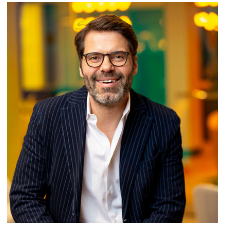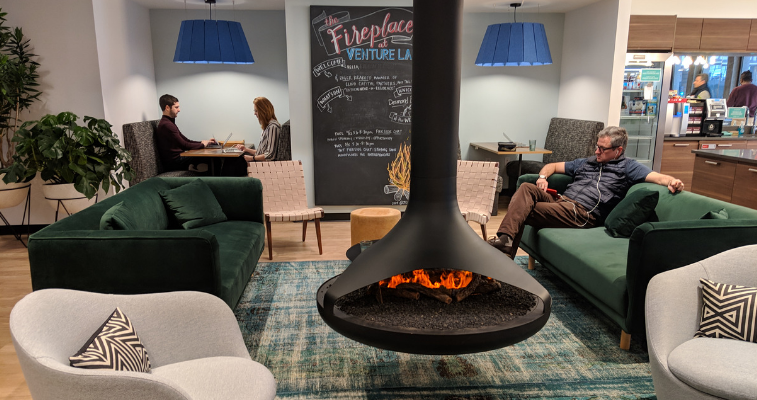Earlier this year, Venture Lane, a new startup accelerator/co-working space, opened in Government Center. The organization has a specific focus: guiding startups that are starting to gain traction by not only providing them with a space to work and collaborate with others but also giving access to mentors as well.
Venture Lane’s Founder Christian Magel had a chance to speak with us about the organization and how they are assisting early-stage startups. Magel also touched upon his own career as a serial entrepreneur and what led him down the path of helping other entrepreneurs.
Colin Barry [CB]: Let’s talk about your career. You’ve been involved with tech companies and now you’re helping them out. How did you get started doing that?
Christian Magel [CM]: In 1995, when the internet revolution came around, I started working for an internet media company before turning my attention to more web-related projects. I completed my first project in 1996, which was a B2B platform for entertainment media. From then on, I was hooked on the craziness of the space. My background is in marketing, especially with figuring out go-to-market strategies, a skill in high demand in the early days of the Internet.

The first startup I joined was LetsBuyIt.com, which was an early eCommerce website founded in Sweden. At the time, LetsBuyIt.com was the second largest funded startup in Europe. It was focused on group buying long before Groupon popularized it. This was a new frontier for me and nothing was prewritten, so figuring out strategies was challenging.
Come 2005, my business partners (Rolf Hansen, Andy Perreiter and Thomas Enge) and I started another company called simyo, which was an online-only telecom service. Think of it as being similar to Virgin Mobile, where you have more control over your mobile service and all benefits of e-commerce. We ended up rolling out into five European countries and helping transform the telecom industry, mainly because we were a customer champion and more tech-driven, as opposed to our competitors who had shops, subsidiaries and lock-in contracts.
My business partners and I then met Peter O’Connell, an Australian entrepreneur who wanted to bring a similar business to the country [Australia]. We hopped on the plane to Sydney and after half-a-day, we were ready to start a business, called Amaysim, another online-enabled telecom service. At the time, we built the largest independent mobile operator in Australia with over AUD 200 mio. in revenue. In 2015, we had an opportunity to register for an IPO and after the company went public, we all decided to take a break; two of the founders went back to Europe, and my wife (who is from Boston) and I came to the United States. Now, at this point, I had been back-and-forth to Boston for nearly 20 years. I’ve always loved Boston and the tight-knit community here.
CB: So, now on to Venture Lane. How did the idea for that come about?
CM: Once I moved to Boston, I started looking at what was out there and what kind of business I could build that’s scalable and one that can impact early-stage companies. Specifically, I wanted to positively impact the lives of both the founders and the companies they are building. I started looking around and noticed that there were tons of open working spaces, but a lot of these places may have lost their mojo, so to speak; they weren’t catering towards the real needs of an early stage tech startup. I also found a thriving scene of accelerators, who are doing great things for the community but are selective and only take in companies for a short period of time. I wanted to create a space that was the best of both worlds and curate a hub for early-stage tech companies.
Venture Lane has three goals in mind: creating a community, creating real impact through mentors and connections, and giving entrepreneurs space where they and their teams can take advantage of their momentum without having to give up equity.
CB: Why focus on just early-stage companies and why not go for the companies that have raised a Series A or have raised more than that?
CM: We want to help companies gain stability by offering our assistance. If you ask an entrepreneur about the mistakes they’ve made early on, they can usually point to one or two things, and we want to share our own experiences to help make a difference for the startups in Venture Lane.
At this part of their lifespan, early-stage companies are relying on shared resources and are looking for a way to connect with other founders. However, it is a stage where a lot can go wrong and a company could fail, so providing mentorship and enabling collaboration is important. When it comes to resources, say, for example, you don’t have a CFO. Why not share a CFO with another company? And then, when you're ready to take off, the CFO can decide which company to join.
CB: Currently, there are six startups stationed here with a handful being Techstars or Y Combinator alumni. How did you come across these companies and how did they become a part of the space?
CM: Full disclosure: this is not the kind of space where we advertised that we were taking in companies. Since myself and our staff were plugged into the Boston tech community, all of the referrals were through word-of-mouth, or through private contacts. One thing that unites all of the startups in the space, however, is that they all have an existing product and a smart and talented team. They are well-positioned for high growth.
Another factor is the people factor, meaning we want to bring in folks who are willing to be team players. It reminds me of a rugby team in New Zealand that brought in all of these star players, but the organization made sure the team was the star, not just one particular player.
CB: One thing that really stands out to me is the design and layout of Venture Lane’s offices and lobby. Did you have a hand in designing the space?
CM: We had a very capable design and architect group, the Baker Design Group, who also designed the TripAdvisor building out in Needham. It was a very collaborative approach, where every design idea and furniture choice was decided amongst the group. It took six months to create a space that cultivates this kind of collaborative, flexible environment.
Frankly, for me, the fun was in getting to work with Baker Design Group. We wanted to make it fun and attractive, but also efficient for workflow. Think about it: you come into an office and you spend all of this time looking at a screen. Sometimes, it's nice to look at something else to spark your imagination. Some people have said that it has a mid-60s European feel, which actually fits the time period when the building was first built.

CB: Can you share some future plans for Venture Lane?
CM: Of course! Our big focus is to look for 20 or so companies that are on fire to bring the space to full capacity. We also just introduced our programming, so we will be hosting weekly roundtables or workshops and more advisors to help the companies out. However, we want to focus on making this a sustainable business and we want to be the best place to work if you are an early-stage company in Boston.
Colin Barry is an Editor & Staff Writer to VentureFizz. Follow him on Twitter @ColinKrash
Images courtesy of Venture Lane

